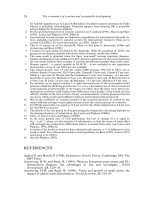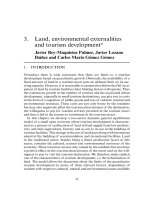THE ECONOMICS OF MONEY,BANKING, AND FINANCIAL MARKETS 197
Bạn đang xem bản rút gọn của tài liệu. Xem và tải ngay bản đầy đủ của tài liệu tại đây (30.36 KB, 1 trang )
PA R T I I I
Financial Institutions
Chapter 8
An Economic Analysis of Financial Structure
Chapter 9
Financial Crises and the Subprime Meltdown
*
Chapter 10 Economic Analysis of Financial Regulation
Chapter 11 Banking Industry: Structure and Competition
Chapter 12 Nonbank Financial Institutions
CRISI S AN D RESP O NSE : BA ILO UT PACKAG E S
IN TH E TR IL LI ON S O F DO LL ARS
In response to the subprime crisis in the United States, governments and central
banks around the world departed significantly from their traditional policy tools
and introduced new facilities, pouring trillions of dollars into financial institutions.
In the United States, for example, the House of Representatives passed the
Emergency Economic Stabilization Act on October 3, 2008. This stunning $700 billion bailout package sought to promote recovery from the subprime financial crisis by authorizing the U.S. Treasury to purchase troubled mortgage assets from
struggling financial institutions or to inject capital into banking institutions. To
calm fears further, the Act raised the federal deposit insurance limit temporarily
from $100 000 to $250 000.
The initial bill was voted down on September 29 when constituents flooded
their representatives with complaints about bailing out the greedy Wall Street executives behind the crisis. The debate in the United States pitted Wall Street against
Main Street: Bailing out financial institutions was seen as being in opposition to
helping struggling homeowners. How could injecting capital into the financial system help those fearful of losing their job or, worse yet, suddenly without work?
The central role of financial institutions in the working of the economy the
focus of Part III was overlooked. Banks and other financial institutions make
financial markets work by moving funds from people who save to people who
have productive investment opportunities. That bank branch on Main Street was
not going to be able to lend freely to a small business owner or recent university
graduate looking to fund a new car purchase until capital once again flowed.
The financial crisis highlights how the financial system changes over time, be
it from financial innovations or hard lessons from crises such as the one at hand.
Chapter 8 analyzes financial structure in Canada and in the rest of the world. In
Chapter 9, we develop a framework to understand the dynamics of financial
crises and focus in particular on the red-hot subprime crisis of 2007 2008. In
Chapter 10, we extend the economic analysis developed in Chapter 8 to understand the motivations for bank regulation and we examine the pitfalls in the regulatory process. Chapter 11 examines the development of the Canadian banking
system over time and the growing internationalization of banking. In Chapter 12,
we look at the business of nonbank financial institutions.
165









